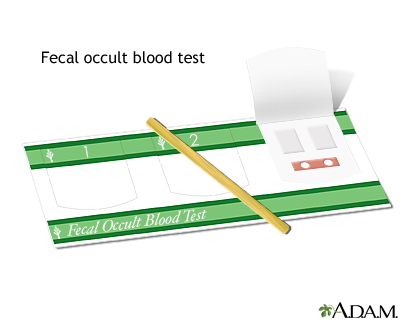HS_PID_1_GID_003758_PROD
A fecal culture is a lab test to find organisms in the stool (feces) that can cause gastrointestinal symptoms and disease.
How the Test is Performed
A stool sample is needed.
There are many ways to collect the sample.
You can collect the sample:
- On plastic wrap. Place the wrap loosely over the toilet bowl so that it is held in place by the toilet seat. Put the sample in a clean container given to you by your health care provider.
- In a test kit that supplies a special toilet tissue. Put it in a clean container given to you by your provider.
Do not mix urine, water, or toilet tissue with the sample.
For children wearing diapers:
- Line the diaper with plastic wrap.
- Position the plastic wrap so that it will prevent urine and stool from mixing. This will provide a better sample.
Return the sample to the laboratory as soon as possible. Do not include toilet paper or urine in the specimen.
In the lab, a technician places a sample of the specimen in a special dish. The dish is then filled with a gel that boosts the growth of bacteria or other germs. If there is growth, the germs are identified. The lab technician may also do more tests to determine the best treatment.

Fecal occult blood test
A fecal occult blood test is a noninvasive test that detects the presence of hidden blood in the stool. Blood in the stool that is not visible is often the first, and in many cases the only, warning sign that a person has colorectal disease, including colon cancer.
How to Prepare for the Test
You will get a collection container for the stool specimen.
How the Test will Feel
There is no discomfort.
Why the Test is Performed
The test is performed when your health care provider suspects that you may have a gastrointestinal infection. It may be done if you have severe diarrhea that does not go away or that keeps coming back.
Normal Results
There are no abnormal bacteria or other organisms in the sample.
Talk to your provider about the meaning of your specific test results.
What Abnormal Results Mean
Abnormal results may mean you have an intestinal infection.
Intestinal infection
Bacterial gastroenteritis occurs when there is a bacterial infection of your stomach or intestines.

Risks
There are no risks.
Considerations
Often other stool tests are done in addition to the culture, such as:
-
Gram stain of stool
Gram stain of stool
A stool Gram stain is a laboratory test that uses different chemical stains to detect and identify bacteria in a stool sample. The Gram stain method ...
 ImageRead Article Now Book Mark Article
ImageRead Article Now Book Mark Article -
Fecal smear
Fecal smear
Fecal smear is a laboratory test of a stool sample. This test is done to check for bacteria and parasites. Presence of organisms in stool shows dis...
 ImageRead Article Now Book Mark Article
ImageRead Article Now Book Mark Article -
Stool ova and parasites exam
Stool ova and parasites exam
Stool ova and parasites exam is a lab test to look for parasites or eggs (ova) in a stool sample. The parasites are associated with intestinal infec...
 ImageRead Article Now Book Mark Article
ImageRead Article Now Book Mark Article
The information provided herein should not be used during any medical emergency or for the diagnosis or treatment of any medical condition. A licensed medical professional should be consulted for diagnosis and treatment of any and all medical conditions. Links to other sites are provided for information only -- they do not constitute endorsements of those other sites.
Beavis KG, Charnot-Katsikas A. Specimen collection and handling for diagnosis of infectious diseases. In: McPherson RA, Pincus MR, eds. Henry's Clinical Diagnosis and Management by Laboratory Methods. 23rd ed. Philadelphia, PA: Elsevier; 2017:chap 64.
Hall GS, Woods GL. Medical bacteriology. In: McPherson RA, Pincus MR, eds. Henry's Clinical Diagnosis and Management by Laboratory Methods. 23rd ed. Philadelphia, PA: Elsevier; 2017:chap 58.
Melia JMP, Sears CL. Infectious enteritis and proctocolitis. In: Feldman M, Friedman LS, Brandt LJ, eds. Sleisenger and Fordtran's Gastrointestinal and Liver Disease. 11th ed. Philadelphia, PA: Elsevier; 2021:chap 110.
Siddiqi HA, Salwen MJ, Shaikh MF, Bowne WB. Laboratory diagnosis of gastrointestinal and pancreatic disorders. In: McPherson RA, Pincus MR, eds. Henry's Clinical Diagnosis and Management by Laboratory Methods. 23rd ed. Philadelphia, PA: Elsevier; 2017:chap 22.
Disclaimer






 All rights reserved.
All rights reserved.